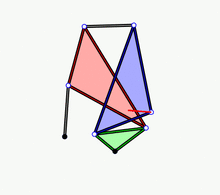Alfred Kempe
| Sir Alfred Kempe | |
|---|---|
 | |
| Born |
July 7, 1849 Kensington, London, England |
| Died |
April 21, 1922 (aged 72) London, England |
| Influenced | Charles Sanders Peirce |
Sir Alfred Bray Kempe D.C.L. F.R.S. (6 July 1849, Kensington, London – 21 April 1922, London) was a mathematician best known for his work on linkages and the four color theorem.
Kempe studied at Trinity College, Cambridge where Arthur Cayley was one of his teachers. He graduated BA (22nd wrangler) in 1872.[1] Despite his interest in mathematics he became a barrister, specializing in the ecclesiastical law. He was knighted in 1913, the same year he became the Chancellor for the Diocese of London. He received the honorary degree D.C.L. from the University of Durham.
In 1876 he published his article On a General Method of describing Plane Curves of the nth degree by Linkwork,[2] which showed that for an arbitrary algebraic plane curve a linkage can be constructed that draws the curve. This direct connection between linkages and algebraic curves was recently named the Kempe's universality theorem[3] that any bounded subset of an algebraic curve may be traced out by the motion of one of the joints in a suitably chosen linkage. Kempe's proof was flawed, and the first complete proof was provided in 2002, based on his ideas.[4][5]
In 1877 Kempe discovered new straight line linkages and published his influential lectures on the subject.[6] In 1879 Kempe wrote his famous "proof" of the four color theorem, shown incorrect by Percy Heawood in 1890. Much later, his work led to fundamental concepts such as the Kempe chain and unavoidable sets.
Kempe (1886) revealed a rather marked philosophical bent, and much influenced Charles Sanders Peirce. Kempe also discovered what are now called multisets, although this fact was not noted until long after his death.[7][8]
Kempe was elected a fellow of the Royal Society in 1881. He was a president of the London Mathematical Society from 1892 to 1894. He was also a mountain climber, mostly in Switzerland.

References
- ↑ "Kempe, Alfred Bray (KM867AB)". A Cambridge Alumni Database. University of Cambridge.
- ↑ A. B. Kempe, (1876) On a General Method of describing Plane Curves of the nth degree by Linkwork. Proceedings of the Royal Society.
- ↑ A. Saxena (2011) Kempe’s Linkages and the Universality Theorem, RESONANCE
- ↑ M. Kapovich and J. J. Millson (2002), Universality theorems for configguration spaces of planar linkages Topology, Pergamon Press.
- ↑ Demaine, Erik; O'Rourke, Joseph (2007), "3.2 Kempe's Universality Theorem", Geometric Folding Algorithms, Cambridge University Press, pp. 31–40, ISBN 978-0-521-71522-5.
- ↑ A. B. Kempe (1877) How to draw a straight line; a lecture on linkages, London: Macmillan and Co.
- ↑ A. B. Kempe, (1886) "A memoir on the theory of mathematical form," Philosophical Transactions of the Royal Society of London 177: 1-70
- ↑ Ivor Grattan-Guinness (2000) The Search for Mathematical Roots 1870-1940. Princeton Univ. Press
External links
- Works by or about Alfred Bray Kempe at Internet Archive
- O'Connor, John J.; Robertson, Edmund F., "Alfred Kempe", MacTutor History of Mathematics archive, University of St Andrews.
- From the Cornell University archives: A. B. Kempe (1877) How to draw a straight line; a lecture on linkages, London: Macmillan and Co.
- Found at Project Gutenberg: A. B. Kempe (1877) How to draw a straight line; a lecture on linkages, London: Macmillan and Co.
- Examples of Kempe's Universality Theorem, Mechanical computation and algebraic curves
- Automatic generation of Kempe Linkages for Algebraic Curves.
